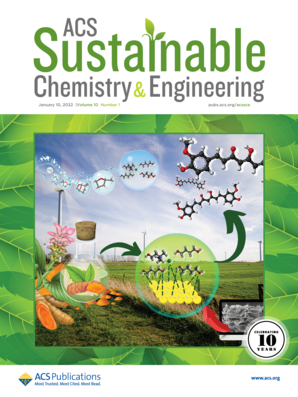光响应气体扩散电极的无辅助光电化学CO2转化为液体产物
IF 7.1
1区 化学
Q1 CHEMISTRY, MULTIDISCIPLINARY
引用次数: 0
摘要
合适的半导体作为光电极的组合可以持续地利用阳光提供无辅助的二氧化碳转换;然而,目前很少有报道描述这样的成就。在这里,乙醇和甲酸盐在一个光反应器中产生,光反应器由含有Cu2WO4的光响应气体扩散电极(GDE)组装而成。由带隙能和平带电位(EFB)值构建的能量图表明,Cu2WO4导带边缘的位置适合促进不同产物的CO2还原。采用沉积在钛箔上的BiVO4作为光阳极;以Ti| bivoi模板成功合成大面积Ti|BiVO4;FeOOH/NiOOH的额外沉积减少了EFB和电荷重组,提高了O2析出反应的光阳极性能。在含NaHCO3水溶液的h型反应器中组装了以co2为馈源的GDE/Cu2WO4 (7.5 cm2)光阴极和Ti|BiVO4/FeOOH/NiOOH (9.0 cm2)光阳极。在照射下,这些相关的光电极提供了0.7 mA自发电流的热力学要求,并且在没有任何外部偏压的情况下,在阴极产生甲酸(16.5 μg h-1 cm-2)和乙醇(1.9 μg h-1 cm-2),太阳能-燃料效率分别为0.07%和0.005%。这种光反应器可以为设计利用阳光实现二氧化碳增值的可持续装置提供灵感。本文章由计算机程序翻译,如有差异,请以英文原文为准。

Unassisted Photoelectrochemical CO2 Conversion into Liquid Products by a Light-Responsive Gas-Diffusion Electrode
The combination of suitable semiconductors as photoelectrodes could sustainably provide unassisted CO2 conversion using sunlight; however, few reports describe such achievement at this time. Herein, ethanol and formate were produced in a photoreactor assembled with a photoresponsive gas-diffusion electrode (GDE) containing Cu2WO4. The energy diagram, built from band gap energy and flat band potential (EFB) values, shows that the position of the Cu2WO4 conduction band edge is suitable to promote CO2 reduction in different products. BiVO4 deposited on titanium foil was used as the photoanode; large-area Ti|BiVO4 was successfully synthesized from the Ti|BiOI template; additional deposition of FeOOH/NiOOH decreased EFB and charge recombination, improving the photoanode performance for the O2 evolution reaction. The CO2-fed GDE/Cu2WO4 (7.5 cm2) photocathode and the Ti|BiVO4/FeOOH/NiOOH (9.0 cm2) photoanode were assembled in a H-type reactor containing NaHCO3 aqueous solution. Under irradiation, these associated photoelectrodes supplied the thermodynamic requirements for a spontaneous current flow of 0.7 mA and, without any external bias, produced formate (16.5 μg h–1 cm–2) and ethanol (1.9 μg h–1 cm–2) at the cathode with solar-to-fuel efficiency of 0.07 and 0.005%, respectively. This photoreactor can be an inspiration for designing sustainable devices for CO2 valorization using sunlight.
求助全文
通过发布文献求助,成功后即可免费获取论文全文。
去求助
来源期刊

ACS Sustainable Chemistry & Engineering
CHEMISTRY, MULTIDISCIPLINARY-ENGINEERING, CHEMICAL
CiteScore
13.80
自引率
4.80%
发文量
1470
审稿时长
1.7 months
期刊介绍:
ACS Sustainable Chemistry & Engineering is a prestigious weekly peer-reviewed scientific journal published by the American Chemical Society. Dedicated to advancing the principles of green chemistry and green engineering, it covers a wide array of research topics including green chemistry, green engineering, biomass, alternative energy, and life cycle assessment.
The journal welcomes submissions in various formats, including Letters, Articles, Features, and Perspectives (Reviews), that address the challenges of sustainability in the chemical enterprise and contribute to the advancement of sustainable practices. Join us in shaping the future of sustainable chemistry and engineering.
 求助内容:
求助内容: 应助结果提醒方式:
应助结果提醒方式:


